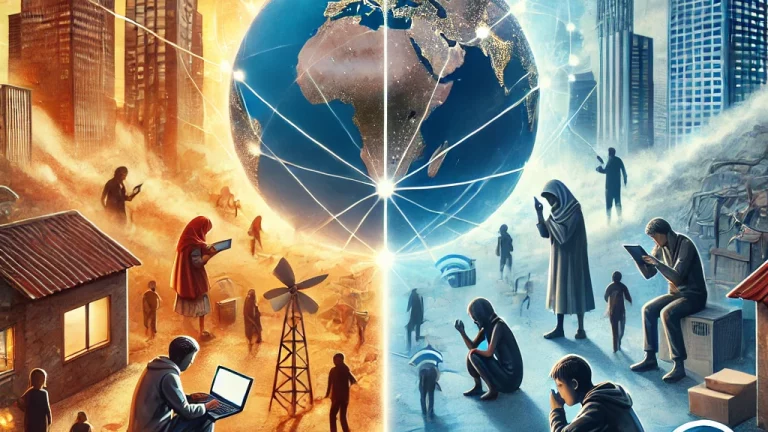
The Digital Divide: Addressing Global Disparities in Internet Access
Introduction: What is the Digital Divide?
In today’s increasingly interconnected world, the internet has become an indispensable part of daily life. It facilitates communication, education, healthcare, and economic opportunities. However, not everyone has equal access to this critical resource. The term “digital divide” refers to the gap between individuals and communities who have access to modern information and communication technologies (ICT) and those who do not. This divide can exist within countries, between urban and rural areas, or even on a global scale between developed and developing nations.
Addressing the digital divide is not just a technological challenge; it is a social and economic imperative. Without equitable internet access, billions of people risk being left behind in the digital age.
The Global State of Internet Access
While internet penetration rates have improved significantly over the past two decades, disparities remain stark:
- Developed vs. Developing Nations: According to the International Telecommunication Union (ITU), over 2.7 billion people worldwide still lack internet access, with the majority residing in low-income and developing countries.
- Urban vs. Rural Areas: Even in developed countries, rural communities often face limited internet infrastructure, resulting in slower speeds and higher costs compared to urban areas.
- Socioeconomic Factors: Income, education level, and age are significant determinants of internet access. Wealthier individuals and younger populations are more likely to be connected, leaving marginalized groups at a disadvantage.
- Gender Gap: Women, particularly in developing nations, are 23% less likely than men to use the internet. This disparity is often due to cultural, educational, and economic barriers.
The Impacts of the Digital Divide
The lack of internet access has profound implications across multiple sectors:
- Education: The COVID-19 pandemic highlighted the critical role of internet access in education. Students without reliable internet struggled to participate in remote learning, exacerbating existing educational inequalities.
- Economic Opportunities: Internet access opens doors to job opportunities, e-commerce, and financial services. Communities without it are often excluded from the digital economy, perpetuating cycles of poverty.
- Healthcare: Telemedicine and online health resources are transforming healthcare delivery. However, those without internet access cannot benefit from these advancements, resulting in disparities in healthcare outcomes.
- Civic Engagement: The internet empowers citizens to participate in democratic processes and access government services. Lack of access can lead to political disenfranchisement and social exclusion.
Challenges to Bridging the Gap
Efforts to close the digital divide face several challenges:
- Infrastructure Costs: Building internet infrastructure, especially in remote or underserved areas, is costly and logistically challenging. This is particularly true for regions with rugged terrain or sparse populations.
- Affordability: Even when infrastructure is available, high costs of devices and internet services can be prohibitive for low-income households.
- Digital Literacy: Access alone is not enough. Many individuals lack the skills needed to use the internet effectively, further limiting its benefits.
- Cultural and Language Barriers: Content on the internet is often dominated by a few major languages, making it inaccessible to those who speak less common languages.
Solutions to Narrow the Digital Divide
Closing the digital divide requires coordinated efforts from governments, private companies, and non-governmental organizations. Here are some key strategies:
- Investing in Infrastructure: Governments and private companies must work together to build affordable and reliable internet infrastructure. Initiatives like satellite internet services, such as Starlink, aim to provide connectivity to remote areas.
- Subsidizing Costs: Subsidies for low-income households can make devices and internet services more affordable. Programs like the U.S. Federal Communications Commission’s (FCC) Affordable Connectivity Program are examples of such efforts.
- Promoting Digital Literacy: Training programs that teach digital skills are crucial to ensuring that people can effectively use the internet. Organizations like Code.org and Digital Promise are working to close the skills gap.
- Localized Content: Creating content in local languages and culturally relevant formats can make the internet more accessible to diverse populations.
- Public-Private Partnerships: Collaboration between governments and tech companies can accelerate progress. For example, Google’s Project Loon used high-altitude balloons to provide internet access to remote regions.
Success Stories: Bridging the Gap
Several initiatives worldwide have made significant strides in addressing the digital divide:
- Rwanda’s ICT Strategy: Rwanda has invested heavily in internet infrastructure, aiming to become a regional tech hub. The government’s efforts include providing free Wi-Fi in public spaces and promoting digital literacy.
- India’s Digital India Campaign: This initiative focuses on expanding internet access to rural areas and promoting e-governance. Programs like BharatNet aim to connect every village in India to broadband services.
- Kenya’s Mobile Revolution: Mobile internet has been a game-changer in Kenya, where affordable smartphones and mobile data plans have brought millions online. Services like M-Pesa have revolutionized financial inclusion.
The Role of Technology in Bridging the Divide
Innovative technologies are playing a pivotal role in addressing the digital divide:
- Satellite Internet: Companies like SpaceX and OneWeb are deploying satellite networks to provide global internet coverage, including in remote and underserved areas.
- 5G Networks: The rollout of 5G technology promises faster and more reliable internet access, though its benefits may initially be limited to urban areas.
- Community Networks: Locally owned and operated networks empower communities to manage their internet access, often at a lower cost.
Conclusion: A Call to Action
The digital divide is not just a technological issue—it is a barrier to social and economic equity. Bridging this gap requires a collective effort from governments, businesses, and civil society. By investing in infrastructure, promoting digital literacy, and addressing affordability, we can create a more inclusive digital future.
Ensuring equal internet access is not just about connecting people to technology—it is about empowering individuals, fostering innovation, and building a more equitable world. Let’s work together to ensure that no one is left behind in the digital age.

